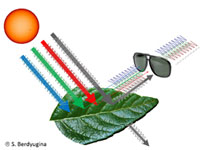| Aug 06, 2015 | |
Searching for life in the Alpha Centauri system |
|
| (Nanowerk News) A new approach to searching for life on other planets: An international team has discovered that biopigments of plants, so-called biological photosynthetic pigments, leave behind unique traces in the light they reflect. Prof. Dr. Svetlana Berdyugina from the Institute of Physics of the University of Freiburg and the Freiburg Kiepenheuer Institute for Solar Physics studied these biosignatures together with researchers from the University of Hawaii at Manoa, USA, and the University of Aarhus, Denmark, with the help of polarization filters: If biopigments were present as a sign of life on a planet, they would leave behind a detectable polarized signature in the reflected light. | |
 Searching for traces of life on exoplanets in reflected light. (Illustration: Svetlana Berdyugina) The scientists have now published their findings in the International Journal of Astrobiology ("Remote sensing of life: polarimetric signatures of photosynthetic pigments as sensitive biomarkers"). Photosynthetic pigments are plant substances that absorb and reflect particular wavelengths of visible light, making them appear in color in the reflected wave ranges. Biopigments are what gives plants, algae, bacteria, and human skin and eyes their colorful appearance. Chlorophyll pigments in plant leaves, for instance, absorb blue to red light but reflect a small part of green in the visible spectrum and thus appear green. An exception is infrared light: half of it is reflected and the other half passes through the leaf. Carotenoids absorb blue and red light but reflect yellow light and are thus typically red, orange, or yellow in color. |
|
| The scientists discovered that the part of the visible light spectrum reflected in colors by various plants oscillates in particular directions, meaning that it becomes polarized. Each biopigment leaves behind a colorful footprint in the polarized light. | |
| The researchers can detect this biosignature with the help of polarization filters, which function similarly to polarized sunglasses or 3D movie glasses. The signature in the polarized light of plants on distant planets would also be detectable in this way. The high contrast of the biosignatures in the polarized light could be the key for finding them in overwhelmingly bright stellar light that hides exoplanetary signals. | |
| “This technique could be instrumental in searching for life in Alpha Centauri, the planetary system closest to the Sun,” says Berdyugina. | |
| The astrophysicist points out that the star Alpha Centauri B is optimal for searches with current telescopes because it is one of the closest to the Earth. No planet has yet been found in Alpha Centauri B’s habitable zone – the distance from a central star at which a planet can have liquid water on its surface, the precondition for life as we know it on Earth. | |
| “Even before such a planet is found, we can use the polarization technique to search for biosignatures that point to life,” says Berdyugina. | |
| Larger telescopes will be needed to examine more distant planetary systems. Until astronomers build such telescopes, the team aims to search for photosynthetic footprints in the light of the Alpha Centauri system. |
| Source: Albert-Ludwigs-Universität Freiburg |
